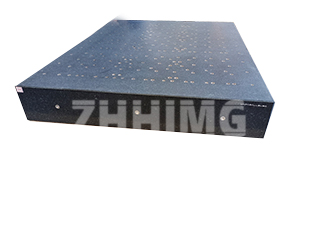The Pillars of Modern Manufacturing
Contemporary manufacturing, defined by precision engineering, micro-engineering, and the burgeoning field of nanotechnology, demands materials with uncompromising stability. As mechanical component tolerances shrink and speeds increase, the search for the ideal structural foundation has led leading global manufacturers away from traditional metals and toward an ancient, naturally superior material: natural granite. At ZHHIMG®, we see this as not just a trend, but a paradigm shift in how high-tech machines are built.
Granite: Stability Forged by Geological Time
For millions of years, granite has been stabilizing deep within the earth’s crust, undergoing a process of natural aging that is impossible to replicate in a factory. This geological conditioning results in an incredibly stable, uniform microstructure and a near-complete release of internal stresses.
This inherent stability translates directly into performance advantages that are critical for achieving ultra-precision:
- Non-Deforming Reliability: Unlike metals, granite exhibits a minimal coefficient of linear expansion. It boasts high strength and hardness, allowing it to maintain stability under heavy loads and normal temperatures without any lasting deformation.
- Precision and Purity: Granite surfaces maintain a precise structure and uniform texture. Crucially, as a non-ductile material, it ensures that even around minor surface imperfections, there is no bulging or distortion, guaranteeing a true plane of reference.
- Maintenance-Free Durability: The material is inherently rust-resistant, acid and alkali-resistant, and non-magnetized. It requires no oiling, does not easily attract dust, and features a characteristic black luster. This makes maintenance exceptionally easy and ensures a long, reliable service life—a significant cost advantage.
The Development Trend: The Convergence of Materials and Technology
Precision machining and micro-machining are no longer niche—they are the core indicators of a nation’s high-tech capability, driving advancements in defense, medical technology, and consumer electronics. These technologies are complex integrations of mechanics, optics, electronics, and computer control.
The critical path forward involves finding materials that can keep pace with these ever-improving systems. This is where granite becomes indispensable:
- Nanotechnology Requirements: As new electromechanical products (including MEMS) seek to enhance precision and reduce dimensions, the need for a non-vibrating, thermally stable base becomes absolute.
- Global Adoption: Major industrialized nations—from the United States and Germany to Japan and Switzerland—have long recognized this advantage, widely utilizing natural granite as the material of choice for precision measuring tools and critical components in advanced machinery. Using natural stone materials for these parts represents a crucial new direction in the development of sophisticated instruments.
Quality Assurance: The Integrity of the Surface
The quality control for granite surface plates, which serve as the ultimate reference tool, is rigorous and uncompromising. Newly manufactured plates must clearly identify the manufacturer (like ZHHIMG®), the accuracy class, specifications, and a unique serial number.
The working surface must present a uniform color, be free of cracks, dents, and loose texture. Critically, we emphasize that defects that affect precision—such as abrasions, scratches, or burns—are strictly disallowed. Importantly, repairing dents or chipped corners on the working surface is prohibited, as it would compromise the integrity of the natural, precise structure. Inspection relies on meticulous visual observation and stringent testing methods.
At ZHHIMG®, we embrace this future. By pairing the geological perfection of our proprietary granite with world-class grinding and metrology, we continue to provide the unshakeable foundation required to push the boundaries of ultra-precision engineering.
Post time: Nov-12-2025

